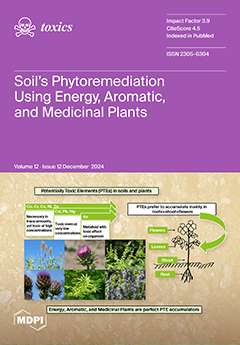Cadmium (Cd) is one of the foremost phytotoxic elements. Its proportion in agricultural soil is increasing critically due to anthropogenic activities. Cd stress is a major crop production threat affecting food security globally. Triacontanol (TRIA) is a phytohormone that promotes growth, development, and metabolic processes in plants. The current study explicates the mitigation of Cd toxicity in
Vigna radiata L. (mung bean) seedlings through the application of TRIA by a seed priming technique under Cd stress. The role of TRIA in improving metabolic processes to promote
Vigna radiata (mung bean, green gram) vegetative growth and performance under both stressed and unstressed conditions was examined during this study. To accomplish this, three doses of TRIA (10, 20, and 30 µmol L
−1) were used to pretreat
V. radiata seeds before they were allowed to grow for 40 days in soil contaminated with 20 mg kg
−1 Cd. Cd stress lowered seed germination, morphological growth, and biomass in
V. radiata plants. The maximum root and shoot lengths, fresh and dry weights of roots, and shoot and seed germination rates were recorded for TRIA2 compared with those of TRIA1 and TRIA3 under Cd stress. In Cd-stressed
V. radiata plants, TRIA2 increased the content of chlorophyll
a (2.1-fold) and
b (3.1-fold), carotenoid (4.3-fold), total chlorophyll (3.1-fold), and gas exchange attributes, such as the photosynthetic rate (2.9-fold), stomatal conductance (6.0-fold), and transpiration rate (3.5-fold), compared with those in plants treated with only Cd. TRIA seed priming increased nutrient uptake (K
1+, Na
1+, Mg
2+, and Zn
2+), total phenolic content, total soluble protein content, and DPPH (2,2-diphenyl-1-picrylhydrazyl) activity. Additionally, TRIA2 significantly reduced the quantity of Cd in the plants (3.0-fold) and increased the metal tolerance index (6.6-fold) in plants contrasted with those in the Cd-treated plants. However, TRIA2 promoted plant growth and biomass production by lowering Cd-induced stress through modifying the plant antioxidant machinery and reducing oxidative stress. The improved yield characteristics of
V. radiata seedlings treated with TRIA suggest that exogenous TRIA may be used to increase plant tolerance to Cd stress.
Full article






